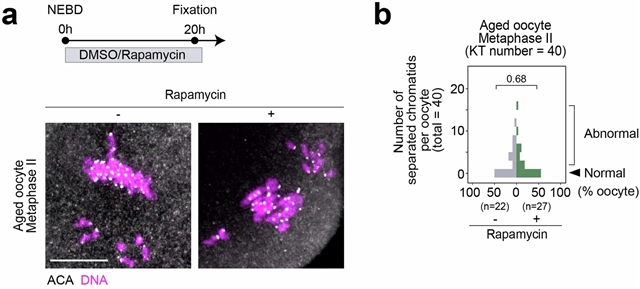
设计基于蛋白质的人工着丝点作为诱饵防止卵母细胞减数分裂错误,这一成果由日本京都大学Tomoya S. Kitajima研究组经过不懈努力而取得。相关论文发表在2025年11月4日出版的《自然—细胞生物学》杂志上。
在这里,小组设计了基于蛋白质的人工着丝点,作为诱饵来防止染色体过早分离。设计的人造着丝点样诱饵是NDC80-NUF2系链蛋白颗粒的亚微尺度球囊,可以通过与染色体着丝点竞争HURP修饰的微管来建立生物定向状态。这种竞争减少了对染色体施加过多的双极微管拉力,从而有效地防止了老年单母卵母细胞减数分裂I和II期间染色体过早分离。这些作用抑制了卵子的非整倍性。本研究提供了一种具有生物相容性的人工着丝点的诱饵策略,以防止卵母细胞中与衰老相关的减数分裂错误。
据介绍,卵母细胞减数分裂时染色体错误分离、流产和先天性疾病。衰老相关的染色体过早分离是染色体错误分离的主要原因。染色体过早分离的有效预防尚未实现。
附:英文原文
Title: Designing protein-based artificial kinetochores as decoys to prevent meiotic errors in oocytes
Author: Zhou, Yuanzhuo, Asai, Kohei, Kyogoku, Hirohisa, Kitajima, Tomoya S.
Issue&Volume: 2025-11-04
Abstract: Chromosome mis-segregation during meiosis in oocytes causes miscarriages and congenital diseases. Ageing-associated premature chromosome separation is a major cause of mis-segregation. Effective prevention of premature chromosome separation has not yet been achieved. Here we design protein-based artificial kinetochores that act as decoys to prevent premature chromosome separation. Designed artificial kinetochore-like decoys are submicroscale clusters of NDC80-NUF2-tethered protein particles that can establish a biorientation-like state by competing with chromosomal kinetochores for HURP-decorated microtubules. This competition reduces excessive bipolar microtubule pulling forces exerted on chromosomes, thereby effectively preventing premature chromosome separation during meiosis I and II in aged mouse oocytes. These effects suppress egg aneuploidy. This study provides a decoy strategy with biocompatible artificial kinetochores to prevent ageing-associated meiotic errors in oocytes.
DOI: 10.1038/s41556-025-01792-w
Source: https://www.nature.com/articles/s41556-025-01792-w
Nature Cell Biology:《自然—细胞生物学》,创刊于1999年。隶属于施普林格·自然出版集团,最新IF:28.213
官方网址:https://www.nature.com/ncb/
投稿链接:https://mts-ncb.nature.com/cgi-bin/main.plex
